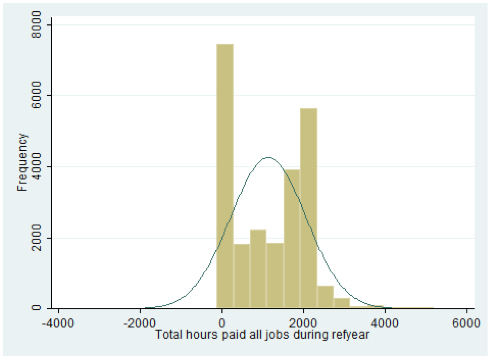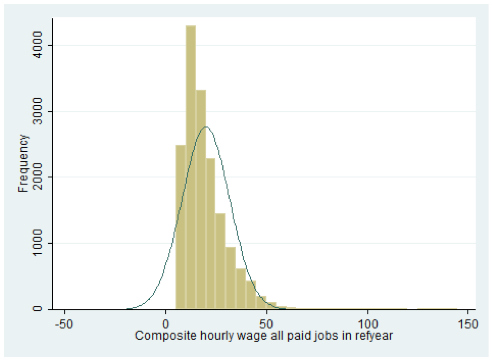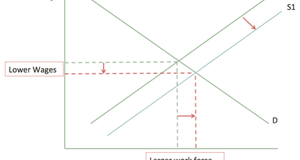The cross-sectional data from the Survey of Labor and Income Dynamics (SLID) Record Layout, 2009 is used for the empirical analysis. The survey includes extensive data concerning demographics, employment, unemployment, occupational history, migration, education, earnings, and parental background of all individuals in Canada, excluding residents of the Yukon, the Northwest Territories and Nunavut, residents of institutions and persons living on Indian reserves. Overall, these exclusions amount to less than 3 percent of the population [SLID].
For the purpose of this study, two datasets from the 2009 SLID data are used: the external cross-sectional person dataset (ecp2009pr) and the external cross-sectional economic family dataset (ec2009ef) were merged together in Stata format. Initially ecp2009pr dataset had observations of 50,900 for both male and female individuals, and the ec2009ef dataset had observations of 26,650 households. In order to match the identity of the given female individual across the two datasets that allows us to match the data from different datasets to the right person, the two datasets were merged. After merger, data on 32,065 females who are in and out of the labor force remain. Out of the 32,065 females, the composite hourly wage of all paid jobs were observed for 16,371 females, the total hours paid all jobs observed for 24,009 females, age of 28,325 females, marital status of 28,264 females, 28,325 of females living with a spouse and not, the number of years of work experience of 24,864 females, support payments of 28,325 females, highest level of education of 28,204 females, 32,065 of females living with a child less than six years old and not, and the non-female income of 28,325 females in total were observed. See the summary statistics in Table 1.3 (Appendix) for a more detailed account of all the variables used in the analysis.
Figure 1.3: Histogram of
hours of labor

The hours variable consists of 24009 observations with a mean of 1129.835 and a standard deviation of 922.4242. Although the histogram of the hours of labor does not look “normal,” in order to ensure that the probability distribution of the sample average of the hours variable follows a normal curve the bootstrap technique was used. It is important for the data to be normally distributed, as without it our statistical tests will not hold. After using the bootstrap technique, the sample average of the variable hours is likely to be normally distributed from 50 simulations with a 95% confidence interval of [118.33, 1141.34] and a bootstrap standard error of 5.869992.
Figure 1.4: Histogram of wage

The wage variable consists of 16371 observations with a mean of 19.89017 and a standard deviation of 11.81493. Likewise, after using the bootstrap technique, the sample average of the variable wage is likely to be normally distributed from 50 simulations with a 95% confidence interval of [19.70432, 20.07602] with a bootstrap standard error of .094824.
Table 1.4 (Appendix) shows that the out of 28,264 observations on the marital status of females, 49% are married, 8.8% are in common-law relationship, 3.5% are separated, 6.7% are divorced, 9.82% are widowed, and 22.2% are singles. Additionally, out of 28,325 observations on females living with spouse and not, 59.3% of females are living with spouse and 40.7% are not (Table 1.5, Appendix). In Table 1.6 (Appendix), it is noted that out of 31,819 observations on females from the ten Canadian provinces, 4.4% are from Newfoundland and Labrador, 2.7% are from Prince Edward Island, 5.9% are from Nova Scotia, 5.8% are New Brunswick, 19.3% are from Quebec, 28.2% are from Ontario, 6.7% are from Manitoba, 7.2% are from Saskatchewan, 10% are from Alberta, and last but not the least 9.8% are from British Columbia. By continuing this way, it is further noted that out of 28,204 observations on the highest level of education of female, 0.4% have never attended school, 0.8% have 1-4 years of elementary school, 7.2% have 5-8 years of elementary school, 7.2% have 9-10 years of elementary and secondary school, 6.6% have 11-13 years of elementary and secondary school (but did not graduate), 15.8% have graduated high school, 7.2% have some non-university postsecondary (no certificate), 5.6% have some university (no certificate), 30.3% have non-university postsecondary certificate, 2.2% have university certificate below Bachelor’s, 12.2% have Bachelor’s degree, and 4.4% have university certificate above Bachelor’s , Master’s, First professional degree in law, Degree in medicine, dentistry, veterinary medicine or optometry, Doctorate (PhD) (Table 1.7, Appendix). And lastly, the kidslt6 variable that was created as an indicator variable by generating a variable less than six from the age of youngest person in economic family shows that out of 32,065 observations, only 9% of women in the sample have a child less than six years old and 91% do not (Table 1.8, Appendix).
In order to obtain the desired parabolic relation, i.e., the backward-bending effect between hours and wage, the square of wage is used as an independent variable. Due to the non-linear relation of age and experience on hours in the existing literature, squares of age and experience are included. The variable province is included to account for the regional differences in labor opportunities captured by regional dummies, and to account for the strong correlation between human capital and labor supply, dummies for the highest level of education attained by the individual female are also included. Other variables in the model are included for similar reasons as well as for purposes of expanding on previous studies concerning the labor supply schedule of Canadian women.
The indicators were coded and the codes were kept for identification purposes in raw data. The males’ earnings or non-female income was measured by subtracting the earnings of the female individual from the total income of a household. The total income of a single household was measured by summing up market income, old age security pension, other government transfers, other taxable income, private retirement pensions, social assistance, universal child care tax benefit, employment insurance benefits, wages and salaries before deductions, and workers’ compensation benefits.Continued on Next Page »
Adkins L.C. & Hill C. (2004). “Bootstrap inferences in heteroscedastic sample selection models: A Monte Carlo investigation.” Working Paper.
Angrist, Joshua D. and Alan B. Krueger. (1999). “Empirical Strategies in Labor Economics.” in Orley C. Aschenfelter and David Card, eds. Handbook of Labor Economics Vol 3C, pp 1277-1366.
Becker, G. S. (1973). “A theory of marriage: Part I.” Journal of Political Economy 81 (4), pp 813-846.
Becker, G. S. (1974). “A theory of marriage: Part II.” Journal of Political Economy 82 (2), pp 11-26.
Borjas, G.J. (1980) “The relationship between wages and weekly hours of work: the role of division bias.” Journal of Human Resources 15, pp 409-423.
Borjas, G.J. (1996). labor Economics. 2nd edition. McGraw-Hill.
Boskin, M.J. (1973) “The econometrics of labor supply.” in Cain and Watts eds (1973).
Boulier, B. L. and M. R. Rosenzweig. (1984). “Schooling, search, and spouse selection: Testing economic theories of marriage and household behavior.” Journal of Political Economy 92 (4), pp 712-732.
Burdett, K. and M. G. Coles. (1997). “Marriage and class.” Quarterly Journal of Economics 112 (1), pp 141-168.
Cain, G. G., and H.W. Watts. (1973) “Toward a Summary and Synthesis of the Evidence,” in Cain and Watts, Income Maintenance and labor Supply, New York: Academic Press, pp 328-67.
Carliner, Geoffrey, Christopher Robinson and Nigel Tomes. (Feb., 1980). “Female labor Supply and Fertility in Canada.” Canadian Journal of Economics, 13 (1), pp 46-64.
CCSD Facts & Stats: Fact Sheet on Canadian labor Market: labor Force Rates. CCSD Facts & Stats: Fact Sheet on Canadian labor Market: labor Force Rates. Retrieved 26 Nov, 2012 from Web site: http://www.ccsd.ca/factsheets/labor_market/rates/index.htm.
Chen, Songnian N. & Shakeeb Khan (2003), ‘Semiparametric estimation of a heteroskedastic sample selection model.’ Econometric Theory 19 (6), pp 1040–1064.
Chris Robinson and Nigel Tomes. (1985). "More on the labor Supply of Canadian Women." Canadian Journal of Economics, Canadian Economics Association, Vol. 18(1), pp. 156-63.
Common Menu Bar Links. The Atlas of Canada. Retrieved 26 Nov, 2012 from Web site: http://atlas.nrcan.gc.ca/auth/english/maps/peopleandsociety/population/gender/sex06.
Cross-Section Regression Estimates of labor Supply Elasticities: Procedures and Problems. Retrieved 05 Apr, 2013 from Web site: http://www.econ.ucsb.edu/~pjkuhn/Ec250A/Class%20Notes/B_StaticLSEsts&Heckit.pdf
Connelly, Rachel, Deborah S. DeGraff, and Deborah Levison. (1996). “Women’s employment and child care in Brazil,” Economic Development and Cultural Change 44(3), pp 619–656.
Dasgupta, Purnamita and Bishwanath Goldar. (2005). “Female labor Supply in Rural India: An Econometric Analysis.” E/265.
Donald (1995), “Two step estimation of heteroskedastic sample selection models.” Journal of Econometrics. (65), pp 347–380.
El-Hamidi, Fatma. (2003). “Labor supply of Egyptian married women: participation and hours of work.” Paper presented at the Annual Meeting of the Middle East Economic Association (MEEA) and Allied Social Science Association (ASSA). January 2-5, 2003.Washington, D.C.
Ermisch, J. and M. Francesconi (2002). “Intergenerational social mobility and assortative mating in Britain.” IZA Discussion Papers 465, Institute for the Study of Labor (IZA).
Fernández, R. (2001). “Education, segregation and marital sorting: Theory and an application to UK data.” NBER Working Papers 8377.
Fernández, R., N. Guner, and J. Knowles (2001). “Love and Money: A Theoretical and Empirical Analysis of Household Sorting and Inequality.” NBER Working Paper, No. 8580.
Fernández, R. and R. Rogerson (2001). “Sorting and long-run inequality.” Quarterly Journal of Economics 116 (4), pp 1305-1341.
Gender Discrimination in Canada. NAJCca. Retrieved 26 Nov, 2012 from Web site: http://www.najc.ca/gender-discrimination-in-canada/.
Gronau, R. (1974). “Wage comparisons – a selectivity bias,” Journal of Political Economy, 82, pp 1119-44.
Hall, Robert E. (1973). “Wages, Income, and Hours of Work in the U.S. Labor Force.” in Glen G. Cain and Harold W. Watts, eds. Income Maintenance and Labor Supply, pp 102-162.
Heckman, J.J. (1974). “Shadow prices, market wages, and labor supply,” Econometrica, 42 (4), pp 679-694.
Heckman, J.J. (1979). “Sample selection bias as a specification error,” Econometrica, 47(1), pp 153-161.
Killingsworth, M.R. (1983). Labor Supply, Cambridge: Cambridge University Press.
Killingsworth, M.R. and J.J. Heckman. (1986). “Female labor supply: a survey.” In Handbook of Labor Economics, Vol. I, O. Ashenfelter and R. Layard (eds.). Amsterdam: North-Holland, pp 102-204.
Kremer, M. (1997). “How much does sorting increase inequality?” Quarterly Journal of Economics 112 (1), pp 115-139.
Lewbel, Arthur (2003), “Endogenous selection or treatment model estimation.” Department of Economics, Boston College, 140 Commonwealth Ave., Chestnut Hill, MA, 02467, USA.,
lewbel@bc.edu.
Lewis, H.G. (1974). “Comments on selectivity biases in wage comparisons,” Journal of Political Economy, 82, pp 1145-1157.
Liu, Haoming and Lu Jinfeng. (2006). “Measuring the Degree of Assortative Mating,” Economics Letters, Elsevier, vol. 92(3), pp 317-322.
Mancuso, D. C. (2000). “Implications of marriage and assortive mating by schooling for the earnings of men.” Ph. D. thesis, Stanford University.
Mare, R. D. (1991). “Five decades of educational assortative mating.” American Sociological Review 56 (1), pp 15-32.
Nakamura, M., A. Nakamura, D. Cullen. (1979). “Job opportunities, the offered wage, and the labor supply of married women,” American Economic Review, 69(5), pp 787-805.
Nakamura, A. and M. Nakamura. (1981). “A comparison of the labor force behavior of married women in the United States and Canada, with special attention to the impact of income taxes.” Econometrica 49, pp 451-489.
Nakamura, A. and M. Nakamura. (1983). “Part-time and full-time work behavior of married women: a model with a doubly truncated dependent variable.” The Canadian Journal of Economics 16, pp 229-257.
Pencavel, J. (1998). “Assortative mating by schooling and the work behavior of wives and husbands.” American Economic Review 88 (2), pp 326-329.
Robins, L. (1930). “On the Elasticity of Demand for Income in Terms of Effort.” Economica (29), pp 123-129.
Sharif, M. (1991). “Poverty and the forward-falling labor supply function: a microeconomic analysis.” World Development. 19 (8), pp 1075-1093.
Survey of labor and Income Dynamics (SLID). Retrieved 30 Nov. 2012 from Web site: http://www23.statcan.gc.ca/imdb/p2SV.pl?Function=getSurvey.
Vella, F. (1998). “Estimating models with sample selection bias: a survey,” Journal of Human Resources, 33 (1), pp 127-169.
Wooldridge, Jeffrey. (2008). Introductory Econometrics. United States of America: South- Western College Pub. 4th edition, pp 606-612 .
Endnotes
1.) The author would like to thank Professor Craig Brett for his invaluable suggestions and comments.
2.) Carliner et al. (1980) in their analysis of 1971 Canadian census data employ three measures of labor supply: labor force participation, hours per week, and weeks per year. Using education as a proxy for potential market wages they found that “greater education of the wife is associated with significantly increased labor supply for all three measures. This suggests that the … substitution effects of an increase in wf [the wife’s wage] … outweigh the income effect.”
3.) The emphasis of the three papers is quite different. Nakamura, Nakamura, and Cullen (1979) report estimates for Canadian women using the 1971 Canadian census. Nakamura and Nakamura (1981) analyze both Canadian and U.S. census data emphasizing the role of taxes. Nakamura and Nakamura (1983) using these same data sets, distinguish further between full-time and part-time workers.
4.) Robinson and Tomes (1985) used data from 1979 Quality of Life Survey, which is a survey conducted by the Institute for Behavioural Research, York University, to deal against the problems of using census data for their study. The survey contained a direct measure of the hourly wage rate and also presented hours of work directly rather than in intervals for a subset of Canadian women.
5.) Source: http://highered.mcgraw-hill.com/sites/dl/free/0070891540/43156/benjamin5_sample_chap02.pdf.
6.) Source: See http://highered.mcgraw-hill.com/sites/dl/free/0070891540/43156/benjamin5_sample_chap02.pdf for the original table.
7.) Standard hours are usually determined by collective agreements or company policies, and they are the hours beyond which overtime rates are paid. The data apply to non-office worker.
8.) Standard hours minus the average hours per week spent on holidays and vacations.
9.) This supply curve shows how the change in real wage rate affects the amount of hours worked by employees. Source: http://en.wikipedia.org/wiki/Backward_bending_supply_curve_of_labor. See the appendix section.
10.) Although the Heckman sample selection model is written in terms of hours of work H, the same equations
apply equally as well to the wage W.
11.) All the steps of the Heckit method is borrowed from lecture notes: Cross-Section Regression Estimates of labor Supply Elasticities: Procedures and Problems.
12.) See http://www23.statcan.gc.ca/imdb/p2SV.pl?Function=getSurvey&SDDS=3889&lang=en&db=imdb&adm=8&dis=2 for more details on the Survey of labor and Income Dynamics (SLID).
13.) Census data is not used as the limitations of Census data in labor economics is well documented [Killingsworth (1983); Angrist and Krueger (1999)]. Income variables are based on respondents’ memory and willingness to disclose this information that is mostly underreported in the Census.
14.) To check for educational assortative mating, the husband’s education variable was added to the actual data that contains only females. After running a single regression of husband’s education on female’s education, a positive correlation for each level of education was found. Hence, husband’s education was added to the model to see how it affects the results. However, it must be noted that adding husband’s education to the model did not change the Heckit results that much. Most importantly, since adding husband's education to the model still results in a positive coefficient of non-female income in the Heckit, the sorting is not on education even though there is a positive correlation among husband's and wife's education. Therefore, the Heckit results with the inclusion of husband’s education to the model are not reported in this paper. Moreover, the existing literature of labor supply of women doesn't include this kind of variable.
15.) It has been mentioned by Adkins and Hill (2004) that “Donald (1995) has studied this problem and suggested a semiparametric estimator that is consistent in heteroscedastic selectivity models. Chen & Khan (2003) has also proposed a semiparametric estimator of this model. More recently, Lewbel (2003) has proposed an alternative that is both easy to implement and robust to heteroskedastic misspecification of unknown form.” The authors themselves proposed a “simple estimator that is easily computed using standard regression software,” and studied the performance of the estimator in a small set of Monte Carlo simulations.
Appendix
Table 1.2: Variable Descriptions
|
hours
|
total hours paid all jobs during 2009
|
|
wage
|
composite hourly wage all paid jobs in 2009
|
|
wagesqrd
|
the square of composite hourly wage all paid jobs
|
|
age
|
female's age, 2009, external cross-sec file
|
|
agesqrd
|
the square of female's age
|
|
marst
|
marital status of female as of December 31 of 2009
1 – female is married
2 – female is in a common-law relationship
3 – female is separated
4 – female is divorced
5 – female is widowed
6 – female is single (never married)
|
|
fslsp
|
female is living with spouse in 2009
1 – Yes
2 - No
|
|
province
|
Province of residence group, household, December 31, 2009
10 - Newfoundland and Labrador
11 – Prince Edward Island
12 – Nova Scotia
13 – New Brunswick
24 – Quebec
35 – Ontario
46 – Manitoba
47 – Saskatchewan
48 – Alberta
59 – British Columbia
|
|
exper
|
number of years of work experience, full-year full-time
|
|
expersqrd
|
the square of number of years of work experience, full-year full-time
|
|
alimo
|
Support payments received
|
|
educ
|
Highest level of education of female, 1st grouping
1 - Never attended school
2 - 1-4 years of elementary school
3 - 5-8 years of elementary school
4 - 9-10 years of elementary and
secondary school
5 - 11-13 years of elementary and
secondary school (but did not
graduate)
6 - Graduated high school
7 - Some non-university postsecondary (no certificate)
8 - Some university (no certificate)
9 - Non-university postsecondary
certificate
10 - University certificate below
Bachelor's
11 - Bachelor's degree
12 - University certificate above
Bachelor's, Master's, First
professional degree in law, Degree
in medicine, dentistry, veterinary
medicine or optometry, Doctorate
(PhD)
|
|
nonfemaleincome
|
income of non-female in the household
|
|
kidslt6
|
female with a child less than six years old
|
|
working
|
total hours paid all jobs greater than zero
|
| |
|
|
|
|
Table 1.3: Summary Statistics of Canadian women
|
Variable
|
Observations
|
Mean
|
Standard Deviation
|
Minimum
|
Maximum
|
|
puchid25(id)
|
32065
|
4012858
|
7414.513
|
4000001
|
4025693
|
|
province
|
31819
|
33.74845
|
14.69714
|
10
|
59
|
|
agyfm
|
32065
|
38.72475
|
25.07988
|
0
|
80
|
|
agyfmg46
|
32065
|
5.924965
|
2.56457
|
1
|
9
|
|
|
|
|
|
|
|
alimo46
|
32065
|
263.0711
|
1860.065
|
0
|
45000
|
|
earng46
|
31745
|
51132.91
|
63660.3
|
0
|
1387250
|
|
age
|
17042
|
43.26998
|
10.50669
|
24
|
60
|
|
marst
|
28264
|
2.8629
|
2.118468
|
1
|
6
|
|
fslac
|
28325
|
1.907326
|
.2899806
|
1
|
2
|
|
|
|
|
|
|
|
fslsp
|
28325
|
1.406884
|
.4912616
|
1
|
2
|
|
hours
|
24009
|
1129.835
|
922.4242
|
0
|
5200
|
|
wage
|
16371
|
19.89017
|
11.81493
|
6
|
142
|
|
exper
|
24864
|
14.9928
|
13.18434
|
0
|
50
|
|
|
|
|
|
|
|
alimo
|
28325
|
249.0071
|
1825.297
|
0
|
45000
|
|
earng42
|
28108
|
20899.72
|
28372.56
|
0
|
539000
|
|
mtinc42
|
28179
|
25065.66
|
30446.84
|
0
|
680000
|
|
oas42
|
28325
|
1210.796
|
2430.963
|
0
|
7750
|
|
ogovtr42
|
28325
|
33.60018
|
181.1052
|
0
|
2400
|
|
|
|
|
|
|
|
ottxm42
|
28325
|
561.278
|
4202.446
|
0
|
120000
|
|
prpen42
|
28325
|
2120.96
|
7977.688
|
0
|
185000
|
|
sapis42
|
28325
|
406.2242
|
2022.65
|
0
|
25000
|
|
uccb42
|
28325
|
139.9682
|
495.2109
|
0
|
7800
|
|
uiben42
|
28325
|
757.8279
|
2789.844
|
0
|
31000
|
|
|
|
|
|
|
|
wgsal42
|
28325
|
19643.28
|
27591.65
|
0
|
525000
|
|
wkrcp42
|
28325
|
130.5137
|
1279.867
|
0
|
32000
|
|
educ
|
28204
|
7.580946
|
2.599754
|
1
|
12
|
|
totalfemincome
|
28179
|
50174.48
|
56331.64
|
0
|
1110900
|
|
nonfemincome
|
28067
|
29301.02
|
32393.06
|
0
|
680000
|
|
|
|
|
|
|
|
wagesqrd
|
16371
|
535.2028
|
918.9231
|
36
|
20164
|
|
agesqrd
|
28325
|
2642.723
|
1801.337
|
256
|
6400
|
|
expersqrd
|
24864
|
398.6038
|
528.935
|
0
|
2500
|
|
|
|
|
|
|
|
kidslt6
|
32065
|
.0902542
|
.28655
|
0
|
1
|
|
working
|
32065
|
.8051458
|
.3960946
|
0
|
1
|
Table 1.4: Marital Status of Canadian women
|
Marital Status
|
Frequency
|
Percent
|
Cumulative
|
|
1 – female is married
|
13,841
|
48.97
|
48.97
|
|
2 – female is in a common-law relationship
|
2,485
|
8.79
|
57.76
|
|
3 – female is separated
|
982
|
3.47
|
61.24
|
|
4 – female is divorced
|
1,900
|
6.72
|
67.96
|
|
5 – female is widowed
|
2,776
|
9.82
|
77.78
|
|
6 – female is single (never married)
|
6,280
|
22.22
|
100.00
|
|
Total
|
28,264
|
100.00
|
|
Table 1.5: Canadian women living with spouse or not
|
Living with spouse or not
|
Frequency
|
Percent
|
Cumulative
|
|
1 - Yes
|
16,800
|
59.31
|
59.31
|
|
2 - No
|
11,525
|
40.69
|
100.00
|
|
Total
|
28,325
|
100.00
|
|
Table 1.6: Residence of Canadian women
|
Province
|
Frequency
|
Percent
|
Cumulative
|
|
10 - Newfoundland and Labrador
|
1,390
|
4.37
|
4.37
|
|
11 – Prince Edward Island
|
870
|
2.73
|
7.10
|
|
12 – Nova Scotia
|
1,877
|
5.90
|
13.00
|
|
13 – New Brunswick
|
1,849
|
5.81
|
18.81
|
|
24 – Quebec
|
6,136
|
19.28
|
38.10
|
|
35 – Ontario
|
8,976
|
28.21
|
66.31
|
|
46 – Manitoba
|
2,124
|
6.68
|
72.98
|
|
47 – Saskatchewan
|
2,304
|
7.24
|
80.22
|
|
48 – Alberta
|
3,172
|
9.97
|
90.19
|
|
59 – British Columbia
|
3,121
|
9.81
|
100.00
|
|
Total
|
31,819
|
100.00
|
|
Table 1.7: Highest level of education attained by Canadian women
|
Highest level of education
|
Frequency
|
Percent
|
Cumulative
|
|
1 - Never attended school
|
111
|
0.39
|
0.39
|
|
2 - 1-4 years of elementary school
|
227
|
0.80
|
1.20
|
|
3 - 5-8 years of elementary school
|
2,025
|
7.18
|
8.38
|
|
4 - 9-10 years of elementary and
secondary school
|
2,037
|
7.22
|
15.60
|
|
5 - 11-13 years of elementary and
secondary school (but did not
graduate)
|
1,869
|
6.63
|
22.23
|
|
6 - Graduated high school
|
4,449
|
15.77
|
38.00
|
|
7- Some non-university postsecondary (no certificate)
|
2,037
|
7.22
|
45.22
|
|
8 - Some university (no certificate)
|
1,584
|
5.62
|
50.84
|
|
9 - Non-university postsecondary
certificate
|
8,548
|
30.31
|
81.15
|
|
10 - University certificate below
Bachelor's
|
617
|
2.19
|
83.34
|
|
11 - Bachelor's degree
|
3,447
|
12.22
|
95.56
|
|
12 - University certificate above
Bachelor's, Master's, First
professional degree in law, Degree
in medicine, dentistry, veterinary
medicine or optometry, Doctorate
(PhD)
|
1,253
|
4.44
|
100.00
|
|
Total
|
28,204
|
100.00
|
|
Table 1.8: Canadian women with or without a child less than six years old
|
Child less than six years old or not
|
Frequency
|
Percent
|
Cumulative
|
|
1 - Yes
|
29,171
|
90.97
|
90.97
|
|
2 - No
|
2,894
|
9.03
|
100.00
|
|
Total
|
32,065
|
100.00
|
|
Table 2.9: OLS Estimates for Canadian Women
|
Dependent Variable: hours of work
|
|
Independent Variables
|
Coefficient
|
|
composite hourly wage of all paid jobs
|
-1.42
[2.70]
|
|
the square of composite hourly wage of all paid jobs
|
-.065**
[.0327]
|
|
female's age
|
39.23***
[5.01]
|
|
the square of female's age
|
-.49***
[.06]
|
|
1 - Never attended school (base group)
|
---
|
|
2 - 1-4 years of elementary school
|
-104.7
[201.5]
|
|
3 - 5-8 years of elementary school
|
65.4
[115.8]
|
|
4 - 9-10 years of elementary and
secondary school
|
90.5
[110.1]
|
|
5 - 11-13 years of elementary and
secondary school (but did not
graduate)
|
21.25
[111]
|
|
6 - Graduated high school
|
117.3
[105.5]
|
|
7 - Some non-university postsecondary (no certificate)
|
4.36
[106.9]
|
|
8 - Some university (no certificate)
|
-14.6
[107.8]
|
|
9 - Non-university postsecondary
certificate
|
85.8
[105.2]
|
|
10 - University certificate below
Bachelor's
|
61.8
[109.1]
|
|
11 - Bachelor's degree
|
48
[106.2]
|
|
12 - University certificate above
Bachelor's, Master's, First
professional degree in law, Degree
in medicine, dentistry, veterinary
medicine or optometry, Doctorate
(PhD)
|
51.84
[107.8]
|
|
female is living with spouse (base group)
|
---
|
|
female is not living with spouse
|
77.14 ***
[28]
|
|
income of non-female in the household
|
.008***
[.0007]
|
|
1 – female is married (base group)
|
---
|
|
2 – female is in a common-law relationship
|
29.3
[15.98]
|
|
3 – female is separated
|
18.8
[35.14]
|
|
4 – female is divorced
|
20.65
[33.11]
|
|
5 – female is widowed
|
-78.7
[54.71]
|
|
6 – female is single (never married)
|
-23.2
[29.9]
|
|
Support payments received
|
-.013***
[.003]
|
|
female without a child less than six years old (base group)
|
---
|
|
female with a child less than six years old
|
-193.2***
[17.73]
|
|
constant
|
606.7
[149.9]
|
|
Sample size
|
12469
|
|
R-squared
|
0.143
|
* Statistical significance at the 90% level
** Statistical significance at the 95% level
*** Statistical significance at the 99% level
[ ] Heteroskedasticity-robust standard error
Table 2.0: Probit Estimates for Canadian women
|
Independent Variables
|
Coefficient
|
∆P(working) per unit ∆independent variable
|
|
female's age
|
.041***
(.012)
|
.0164
|
|
the square of female's age
|
-.001***
(.0001)
|
-.0004
|
|
number of years of work experience, full-year full-time
|
.09***
(.004)
|
.036
|
|
the square of number of years of work experience, full-year full-time
|
-.001***
(.0001)
|
-.0004
|
|
1 - Never attended school (base group)
|
---
|
---
|
|
2 - 1-4 years of elementary school
|
.61
(.441)
|
.244
|
|
3 - 5-8 years of elementary school
|
.87**
(.35)
|
.348
|
|
4 - 9-10 years of elementary and
secondary school
|
1.11***
(.351)
|
.444
|
|
5 - 11-13 years of elementary and
secondary school (but did not
graduate)
|
1.16***
(.354)
|
.464
|
|
6 - Graduated high school
|
1.36***
(.35)
|
.544
|
|
7 - Some non-university postsecondary (no certificate)
|
1.25***
(.35)
|
.5
|
|
8 - Some university (no certificate)
|
1.34***
(.35)
|
.536
|
|
9 - Non-university postsecondary
certificate
|
1.56***
(.35)
|
.624
|
|
10 - University certificate below
Bachelor's
|
1.64***
(.36)
|
.656
|
|
11 - Bachelor's degree
|
1.8***
(.35)
|
.72
|
|
12 - University certificate above
Bachelor's, Master's, First
professional degree in law, Degree
in medicine, dentistry, veterinary
medicine or optometry, Doctorate
(PhD)
|
1.96***
(.353)
|
.784
|
|
10 - Newfoundland and Labrador (base group)
|
---
|
---
|
|
11 – Prince Edward Island
|
.301***
(.108)
|
.1204
|
|
12 – Nova Scotia
|
-.1
(.082)
|
-.04
|
|
13 – New Brunswick
|
-.001
(.083)
|
-.0004
|
|
24 – Quebec
|
-.08
(.07)
|
-.032
|
|
35 – Ontario
|
-.146
(.07)
|
-.0584
|
|
46 – Manitoba
|
.044
(.081)
|
.0176
|
|
47 – Saskatchewan
|
.0454
(.081)
|
.0182
|
|
48 – Alberta
|
.052
(.076)
|
.0208
|
|
59 – British Columbia
|
-.106
(.076)
|
-.0424
|
|
constant
|
-1.22
(.427)
|
---
|
|
Pseudo R-squared
|
0.17
|
---
|
|
Proportion of women who worked
|
0.42
|
---
|
|
Final value of log of likelihood function
|
-5637.7
|
---
|
* Statistical significance at the 90% level
** Statistical significance at the 95% level
*** Statistical significance at the 99% level
( ) Usual standard error
Table 2.1: Heckit Estimates for Canadian Women
|
Dependent Variable: hours of work
|
|
Independent Variables
|
Coefficient
|
|
composite hourly wage of all paid jobs
|
-9.1***
(1.41)
|
|
the square of composite hourly wage of all paid jobs
|
-.006
(.015)
|
|
female's age
|
19.8***
(5.13)
|
|
the square of female's age
|
-.235***
(.061)
|
|
1 - Never attended school (base group)
|
---
|
|
2 - 1-4 years of elementary school
|
-84.8
(334.3)
|
|
3 - 5-8 years of elementary school
|
-18.02
(280)
|
|
4 - 9-10 years of elementary and
secondary school
|
-50.34
(278.3)
|
|
5 - 11-13 years of elementary and
secondary school (but did not
graduate)
|
-148.6
(279.2)
|
|
6 - Graduated high school
|
-67.43
(277.2)
|
|
7 - Some non-university postsecondary (no certificate)
|
-188.9
(277.7)
|
|
8 - Some university (no certificate)
|
-202.9
(278.2)
|
|
9 - Non-university postsecondary
certificate
|
-125.9
(277.1)
|
|
10 - University certificate below
Bachelor's
|
-183.8
(279.1)
|
|
11 - Bachelor's degree
|
-171.1
(277.4)
|
|
12 - University certificate above
Bachelor's, Master's, First
professional degree in law, Degree
in medicine, dentistry, veterinary
medicine or optometry, Doctorate
(PhD)
|
-174.3
(278.1)
|
|
female is living with spouse (base group)
|
---
|
|
female is not living with spouse
|
60.9**
(25.6)
|
|
income of non-female in the household
|
.01***
(.0003)
|
|
1 – female is married (base group)
|
---
|
|
2 – female is in a common-law relationship
|
19.5
(17)
|
|
3 – female is separated
|
24.6
(34.52)
|
|
4 – female is divorced
|
20.3
(31.3)
|
|
5 – female is widowed
|
-73.3
(50.9)
|
|
6 – female is single (never married)
|
-7.3
(27.8)
|
|
Support payments received
|
-.013***
(.003)
|
|
female without a child less than six years old (base group)
|
---
|
|
female with a child less than six years old
|
-172.2***
(17.3)
|
|
constant
|
1292.3
(299.2)
|
|
(Selectivity bias)
|
-314.8
(18.12)
|
|
Sample size
|
13515
|
* Statistical significance at the 90% level
** Statistical significance at the 95% level
*** Statistical significance at the 99% level
( ) Usual standard error





















